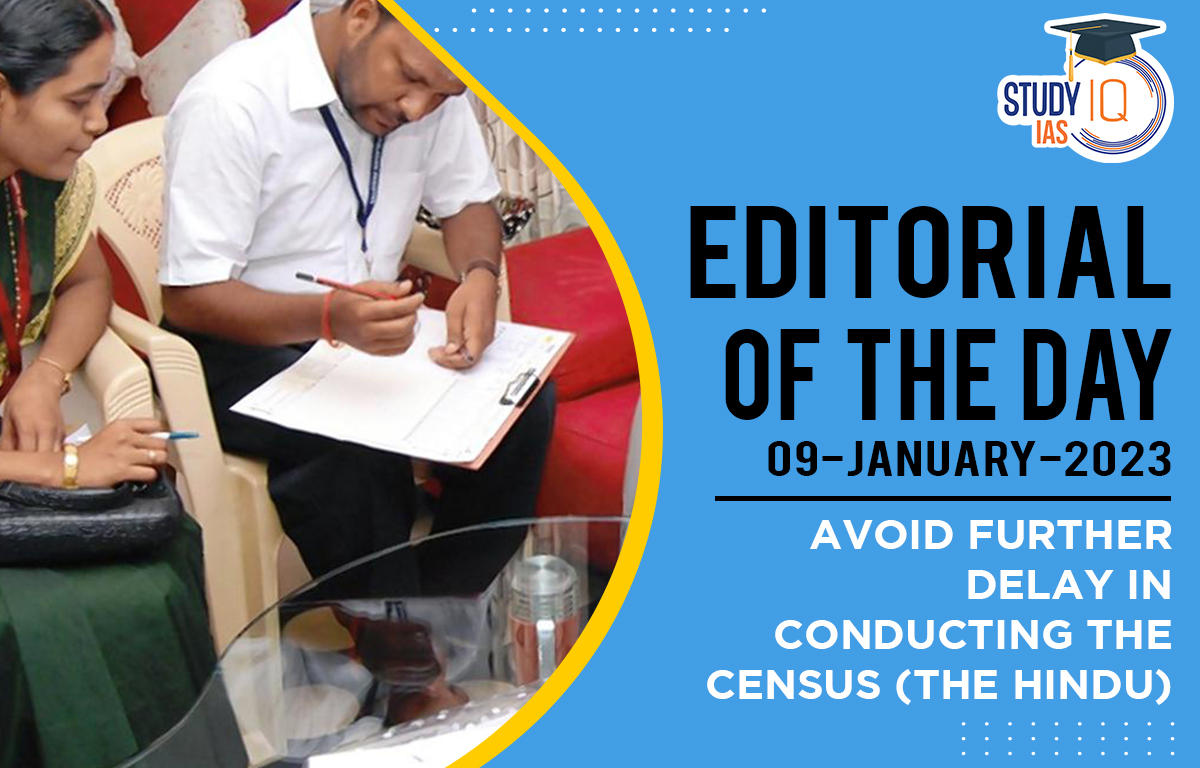Table of Contents
Exam View: Census, Objective of a census, Importance of census, Difference between NPR and the Census, Impact of delay in conducting the Census, Socio-economic caste census (SECC).
In News: Recently, the newspaper reported that the freezing of administrative boundaries that precede the Census would be done with effect from July 1, 2023.
- Population censuses, typically with a semi-decadal (five-year) or decadal frequency are recognised as indispensable to national resource planning. In India, a census is conducted every decade and Census 2021 will be the 16th national census of the country.
- In the Census, data is collected on demographic and various socio-economic parameters like education, SC/ST, religion, language, marriage, fertility, disability, occupation and migration of the individuals.
- While it has been undertaken every 10 years, beginning in 1872 under British Viceroy Lord Mayo, the first complete census was taken in 1881.
- Post 1949, it has been conducted by the Registrar General and Census Commissioner of India under the Ministry of Home Affairs.
- The last census was held in 2011, whilst the next was to be held in 2021. But it has been postponed due to the COVID-19 pandemic.
Legal/Constitutional Backing
- Census is conducted under the provisions of the Census Act, 1948.
- The bill for this Act was piloted by Sardar Vallabhbhai Patel, the then Home Minister of India.
- Article 246: The population census is a Union subject under Article 246 of India Constitution.
- Seventh schedule: It is listed at serial number 69 of the seventh schedule of the constitution.
Objective of a Census

Importance of Census
- Source of Information: The Census alone can provide population data for every village and town in the country. Researchers and Demographers use census data to analyze the growth and trends of the population and make projections.
- Provides most credible statistics: Information on Demography, Economic Activity, Literacy and Education, Housing & Household Amenities, Urbanisation, Fertility and Mortality, SCs and STs, Language, Religion, Migration, Disability, and many other sociocultural and demographic data.
- Good Governance: The data collected through the census is used for administration, planning and policy-making as well as management and evaluation of various programmes by the Government.
- Reservation of seats for SCs and STs: The Census data are used to determine the number of seats to be reserved for SCs and STs in Parliament, State legislatures, local bodies, and government services. In the case of panchayats and municipal bodies, the reservation of seats for SCs and STs is based on their proportion in the population.
- Planning the future: It provides pathways for planning and resolving problems, and fixing deficiencies. Government goes through an analysis over the census data and formulates policies for the future accordingly.
- Counting each and every Indian: The best of sample surveys finds it impossible to beat a census as it carries the promise of counting each and every Indian. A census is when the state connects to every individual, and it will find it hard to hide or duck from the data.
- Giving Grants: Finance Commission provides grants to the states on the basis of population figures available from the Census data.
- Welfare schemes: Identifying the actual beneficiaries, Census is the key to creating identity and affirming it over time. Census data enable neat, inter-temporal comparability.

Difference between NPR and the Census

Impact of Delay in Conducting the Census
A delay in the Census means that the data from the 2011 Census would continue to be used.
- Delimitation/reservation of Constituencies: Panchayats that have seen rapid changes in the composition of their population over the last decade, would mean that either too many or too few seats are being reserved. Delimitation of parliamentary and Assembly constituencies would continue to be based on the 2001 Census till data from a Census after 2026 are published.
- Rural-urban distribution of population has been rapidly changing over the years: There is high population growth in urban areas. Some cities have been growing faster than others through in-migration. For example, areas under the Bruhat Bengaluru Mahanagara Palike grew by 49.3% during 2001-11, while the Municipal Corporation of Greater Mumbai (11.9%), the Delhi Municipal Corporation (11.7%), and Greater Chennai Corporation (7.0%) had much lower growth rates. Kolkata Municipal Corporation recorded a fall in population during the same period.
Socio-economic Caste Census (SECC)
- It is a study of the socio-economic status of rural and urban households and allows the ranking of households based on predefined parameters.
- It is also the first paperless census in India conducted on hand-held electronic devices by the government in 640 districts.
- The flaws in the data stem primarily from the fact that no registry of castes was prepared before conducting the 2011 caste census.
- This resulted in mistakes by enumerators, who spelt the same caste in dozens of different ways.
- Coverage and entitlement under Targeted Public Distribution System (TPDS): Up to 75% of the rural population and 50% of the urban population will be covered under TPDS, with a uniform entitlement of 5 kg per person per month. Under the 2011 Census, India’s population was about 121 crores, hence PDS covered approximately 80 crore people.
- The current delay in Census data would continue to deprive more than 10 crore people of subsidised food entitlements, with the biggest gaps in Uttar Pradesh and Bihar, with 2.8 crore and 1.8 crore projected exclusions respectively.
- Poor targeting of beneficiaries for welfare schemes: Although the Government intends to use Socio-Economic Caste Census data, it failed at budgetary allocation for the projected expansion.
- Census data may not be used to calculate the beneficiaries of most schemes, but it is critical to policy planning, budgeting and administration. A number of schemes need to use the disaggregated age and fertility indicators to assess effectiveness as demographics change over time.
- Covid-19 pandemic: The pandemic resulted in deaths among adults and the aged relatively more than among children. Its impact on age distribution in severely affected areas would be of interest as it would give an indirect estimate of the number of deaths. This would either validate or reject the various estimates of the number of deaths due to the pandemic.
Way Forward
- Minimising the coverage error and content error: It will help in changing the discourse of the government’s programme implementation.
- Digital census: The data collected through a mobile app will reduce the overall time taken to process the census data and to publish the results in time.
- Self-enumeration: Allowing households to self-enumerate is a new initiative but it is unclear how successful it would be in terms of data quality and completeness of coverage.
- Proper training: Proper training of enumerators (data collectors) and organizers should be organised. Also, enumerators should be well paid to keep them motivated, as they are the focal point of data collection and ensuring data accuracy.
- Awareness Campaigns: Launching massive publicity campaigns in order to make people aware about the importance of Census in their life should be organized.
- The first Census after 2026 would be used for delimitation of parliamentary and Assembly constituencies and for apportionment of parliamentary seats among the States. Due to the disparity in growth rates between the States, there could be changes in the distribution of seats in Parliament. That Census is likely to be held in a more politically charged atmosphere. Hence, it is necessary that this Census is done as early as possible.


 Suspension of Operations Pact with Kuki-...
Suspension of Operations Pact with Kuki-...
 Operation Meghdoot: How India Won Siache...
Operation Meghdoot: How India Won Siache...
 Current Affairs 16th April 2024 for UPSC...
Current Affairs 16th April 2024 for UPSC...

















